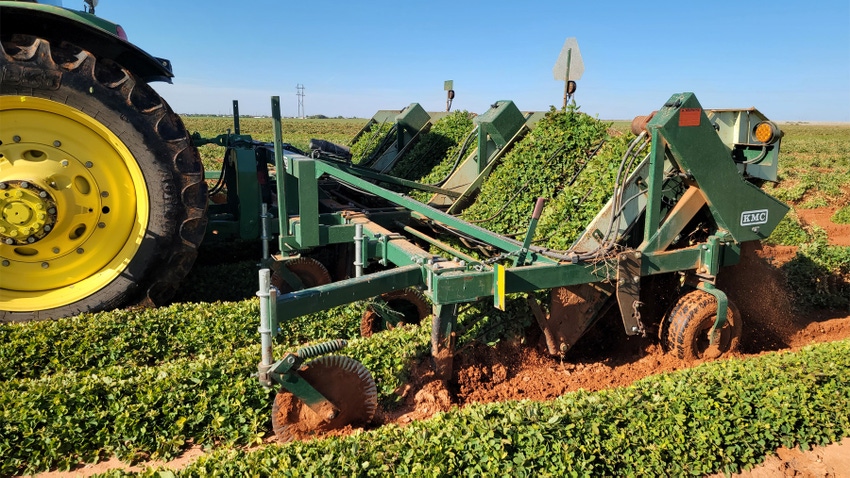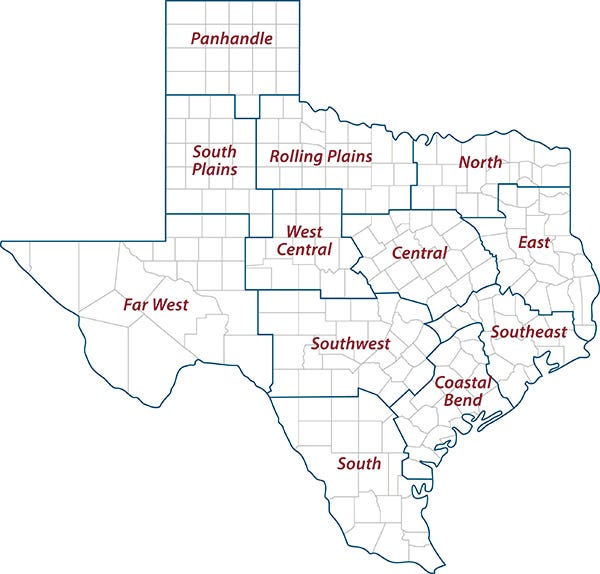
Back-to-back seasons of drought continue to impact planted peanut acres making it another tough year for Texas peanut growers, according to a Texas A&M AgriLife Extension Service expert.
Emi Kimura, AgriLife Extension state peanut specialist, Vernon, said producers who were able to keep their crop under irrigation throughout the drought were able to maintain growth and produce average yields per acre. However, for those who were not able to keep up with moisture demands during a second season of drought and extreme heat suffered another rough season.
Harvested acres were up compared to 205,000 acres last year, according to an October U.S. Department of Agriculture National Agriculture Statistics Service report. The USDA report also forecasted 107% higher production in Texas than last year – 677 million pounds, compared to 328 million pounds in 2022. Peanut yields this season were up 500 pounds per acre over 2022 production and expected to reach 3,300 pounds per acre.
But Kimura said the USDA report does not depict the 2023 peanut growing season. She said 13,000-14,000 acres of the 230,000 peanut acres in Texas were lost to dry, hot conditions.
“It was the second drought season in a row, and that makes it harder,” Kimura said. “Peanuts need even more water, and lower yields in back-to-back seasons makes it hard for growers.”
Peanut growers face tough conditions
The lack of rain and soil moisture in the ground throughout the season left most peanut growers solely reliant on irrigation, Kimura said. That means a farm’s irrigation capacity greatly influenced individual grower outcomes.
The evaporative effect of another arid growing season took its toll on growers’ ability to meet water demands for good pod and peanut development, she said.
Drought delayed crop progress, but there were also weather-related delays at harvest, Kimura said.
“Producers waited a week or two longer than normal to harvest their crop since the rain we received in May and June pushed back planting,” said Kimura. “The drought also slowed down production, so waiting to harvest allowed the crop to mature.”
Progressing peanut prices
Pancho Abello, AgriLife Extension economist, Vernon, released the High Plains Ag Week – Peanut Market update Oct. 18. Peanut prices reached the highest level in the last decade – $545 per ton on average. Abello said demand for peanuts in the U.S. has shifted.
He reported a 9% consumption decrease for peanut candy, snacks and other peanut products, while peanut butter and in-shell peanut consumption increased 6%.
“Even though producers’ yields improved on average, many still struggled to bring in a crop,” Kimura said.
AgriLife Extension district reporters compiled the following summaries:

CENTRAL
The district received some moisture and cooler temperatures later in the week. That moisture continued to help young grain fields. The pecan harvest continued with mostly low yields; fair quality on some irrigated acres and no yield on dryland or irrigated acres that ran out of water. Trees were showing some symptoms of drought after moisture returned to the area. Rust and other fungi were present on trees. Small grains were still being planted. Cool-season grass and small grains already planted were responding well. Wheat that emerged looked excellent. Grazing was anticipated to become more widespread as cool and damp weather continued and winter forages developed further. There were a few reports of isolated armyworms. Walnut and tent caterpillars were higher in number this year. Bermuda grass stem maggots were also noted. Hessian fly larvae were observed in the early planted wheat and remain a concern with growers. Livestock remain in fair to good condition with some supplementation.
ROLLING PLAINS
Optimism for a good winter wheat stand remained last week, with farmers across the district seeing a promising start for the crop. The rains were showing their benefit. Some stockers were even starting to move calves out for grazing on wheat. Topsoil moisture was holding well in most places, and pasture grasses were reported as emerging and holding green, although not growing much. Ranchers with cattle on pasture continued supplementing with some hay and cubes.
COASTAL BEND
The area was in a cooler and wet weather pattern, with reports of 1-3 inches of rain. All fieldwork stopped. Producers were placing orders for seed for next year. Rangeland and pasture conditions were showing improvement. Winter pastures were progressing well and should be even better next week after the widespread rain. Local ranchers got their last hay cutting for the year before the rain arrived. Livestock were doing well, and markets were holding firm. Some pecan harvest continued as weather allowed. Yields were very sporadic, ranging from poor to good.
EAST
Most of the region received rainfall. Marion County reported as much as 2 inches. Ponds and creeks began to fill up. Some winter pastures were growing. Pasture and rangeland conditions were fair to good. Subsoil conditions were adequate to short. Topsoil conditions were adequate. Livestock was doing fair to good with some supplementation taking place. Wild pig damage was reported in hay meadows and pastures. Gopher control was underway.
SOUTH PLAINS
Producers had to wait for the fields to dry out before they could continue stripping cotton and planting wheat. Last week, the district received modest rain showers across the district. Farmers reported that yields for irrigated cotton fields were down 30-50% across the area. A few in the eastern counties reported yields down only 10% due to receiving more rainfall in later July. Early planted wheat was in good condition across much of the district. Some of the later planted wheat hadn’t emerged. Cattle were in good condition, and native pastures across the area were in good condition going into the winter season.
PANHANDLE
The region continued to have very dry conditions. Corn harvest was completed in most counties. Most late sorghum and corn for silage had been harvested. Tillage operations continued, especially on fields where a warm-season forage was chopped and harvested for silage purposes. Additional precipitation was needed to boost the emergence and early growth of recently planted cover crops, including acres of winter wheat planted for forage, grain or dual-purpose use. Winter wheat plantings were ongoing, with some early planting being irrigated for pasture cattle. All dryland wheat suffered from lack of rainfall; only irrigated wheat had progressed. Cotton was limited this year due to weather conditions during planting. Pasture and rangelands were reported as fair to very poor. Producers continued supplemental feeding their herds.
NORTH
Topsoil and subsoil were reported as adequate to short for counties within the region. Pasture and rangelands were reported as fair to very poor for most counties in the district. Heavy rainfall over the past week helped the crop tremendously. Winter pastures were starting to grow and looked good. Ryegrass and oats were growing well thanks to adequate moisture. Some ranchers started to feed hay because the fields were drying up. Summer crops were harvested. Winter wheat and other cool-season grasses were planted and emerged across some counties. Livestock were doing well. There was no disease or insect outbreak in the district.
FAR WEST
Temperatures were warmer, from the mid-80s to low 60s. A cold front persisted for the latter part of the week. Trace amounts of rain were received up to at least 2 inches. The wet ground kept cotton strippers out of the field until it dried out. Most irrigated cotton was harvested. It was dry enough for planters to put a little wheat in the ground. Earlier planted wheat was emerging and looking good. Rangeland had improved slightly due to the extra rainfall and temperatures cooling; however, it was still considered fair to poor. Livestock were in fair condition and were getting fed three times a week. Calves were being weaned. Deer hunters arrived in the region on leases.
WEST CENTRAL
The district experienced average temperatures with cooler mornings and received another inch of rain to sustain soil moisture. Small grain planting was underway, but additional soil moisture was needed to emerge recently planted grain. Cotton harvest was almost complete. Although the district received rain, stock tank and lake levels remained low. Winter annuals appeared in rangelands and pastures, providing some grazing. Fed cattle prices were up at local sale barns. Producers have increased supplemental feeding of their herds to help maintain body condition going into the winter months.
SOUTHEAST
Numerous counties throughout the district experienced rainfall. Pastures were still very dry, and no winter grass was emerging yet. Cooler temperatures swept across the district, and the first frost hit and caused forages to go dormant. Winter wheat that was previously planted was in good shape. Trees began transitioning into dormancy, and there were no pest issues. Producers were getting a final cutting of hay, which was crucial to help with the upcoming winter months. Cow prices were holding steady, and calf prices continued to rise. Producers continued supplemental feeding the cattle they have kept.
SOUTHWEST
Weather conditions in the region were cooler and drizzly, with slow and steady rains providing much-needed moisture in some areas. Precipitation amounts varied, with reports ranged from 0.1 to 2.75 inches. However, there were still areas experiencing dry conditions. The cool and damp conditions at the end of the week impacted livestock markets, causing prices to be slightly lower. Wheat appeared to be in good condition and fully emerged. Some armyworm pressure was observed, likely due to the previous week’s rainfall. Wheat plantings were beginning to increase, and the moisture was expected to benefit the cool-season fields of wheat and oats and rangeland growth. The rains helped the fall corn crop and provided much-needed moisture for winter vegetables, oats and wheat crops. Rainfall continued in the area as the cotton harvest began to round out. Despite the rain, the region was still considered short on moisture. Rangeland conditions were improving, and winter wheat planting was nearing completion. Producers were providing supplemental feed for livestock, and there was a slowdown in shipping stock. Livestock were reported to be in fair condition. Hunters reported average antler growth and average body condition for recent harvests.
SOUTH
Weather conditions continued to cool down across the district, and beneficial rainfall was received. Some producers were continuing peanut harvest, small winter grain planting continued and some previously planted were emerging. Pecan harvest was reported as good. Producers started cutting hay and have hopes of a second cutting with the recent rainfall. Beef cattle producers continued supplemental feeding and culling their herds. Local markets were offering average volumes of cattle. Turkey and deer were moving and more visible as cooler temperatures approached.
Read more about:
DroughtAbout the Author(s)
You May Also Like




